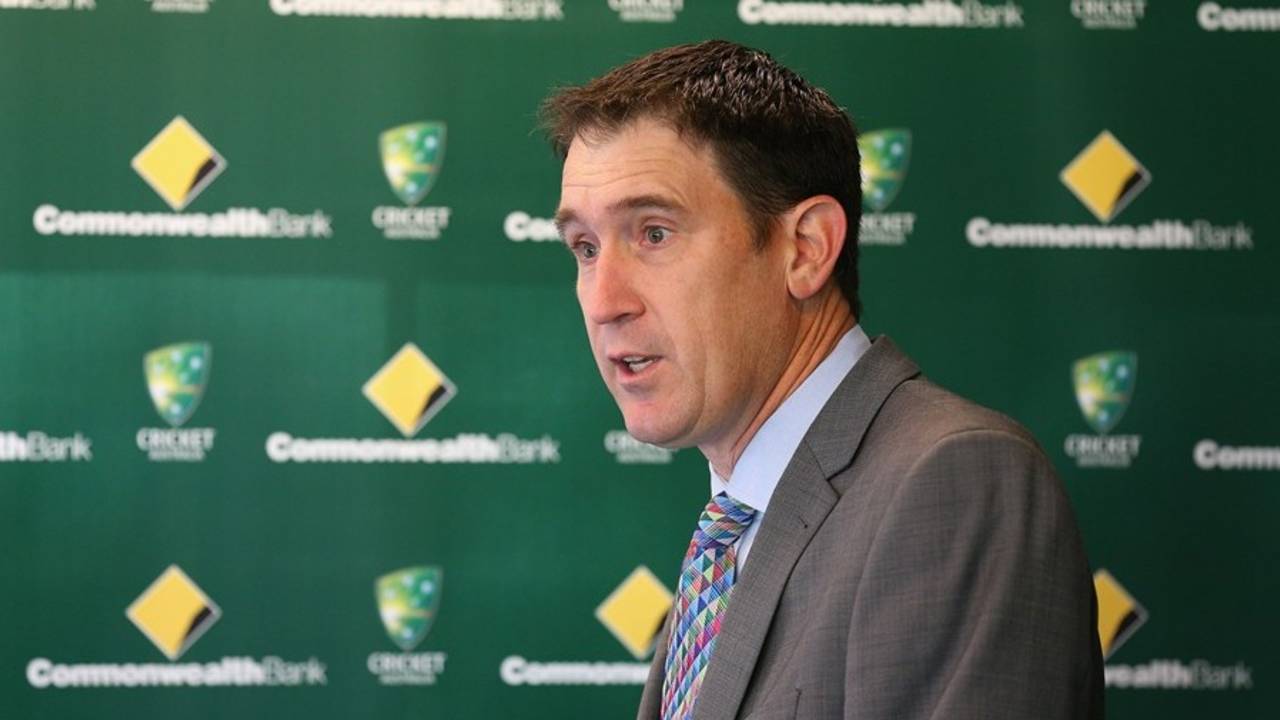Player payment model outdated, says James Sutherland
Cricket Australia CEO James Sutherland explains why he feels the current payment structure for Australian cricketers is in need of a revamp
James Sutherland believes the fixed revenue percentage model has served its time • Getty Images
It is a variation of a model that has stood the test of time over the course of the last 20 years, but in our view, it is a model that has served its purpose and is now outdated. The model we have proposed is one that not only secures increasing guarantees around player payments, but at the same time international cricketers - men and women - for the first time will share in surpluses from international cricket. It's a slight variation on the previous model but an improvement for all of cricket overall.
I was there from the outset in managing the very first model. I'm very clear in having seen it serve its purpose in providing guarantees that were coming from a long way behind in terms of player payments. It's become very competitive in terms of both international and domestic players, and we've seen 63% increases over the last five years for international men, and 53% for domestic men. I'm very comfortable this model has served its time and the model we're proposing will serve Australian cricket well.
The initial purpose of the old model going back to 1997 was to secure payment levels for players and keep the game to account because state cricketers in particular were coming from a long way behind. Over the course of the last two decades, payments to state cricketers in particular have increased significantly, their payments are now highly competitive with the football codes. Over the last five years they've had increases of 53%, so we're very comfortable the model has got player payments to the level intended. International cricketers, men and women, will continue to share in the surpluses of international cricket, but for domestic cricketers there'll be a slightly different model.
One of the real fundamentals in all of this is that international cricket actually funds the game. It funds everything we do, it funds the domestic cricketers' wages, it funds female cricketers' wages, and it plays a really important role in ensuring that we can develop the game from the bottom up - the grassroots but also our domestic competitions, and also ensuring our talented young cricketers have an opportunity to pursue objectives of playing for their country and be paid for it, even though they're playing in competitions that don't generate the revenue.
In terms of funding, the international game by far outweighs any other format of the game. It's true that on the surface, the BBL may be starting to break even in certain quarters, but we've still got a very significant deficit from previous years that we're still trying to recoup from bringing forward the launch of the BBL in the first three or four years before it starts to be profitable. Down the track of course if the BBL is generating significant surpluses, then we could look at that in a different fashion, but right now our proposal is that for surpluses over and above the scenario we've painted, we're prepared to share that with the men's and the women's [international] players.
We've consulted very widely, done a lot of research, a lot of checking to understand how the model stands up and made sure it is in the best interests of the game. That's our responsibility, to ensure we find the right balance for the game at grassroots level to ensure it grows, but also ensure we deliver objectives for international cricketers and domestic cricketers, male and female. It's exciting to be making a seismic shift in the way female cricketers are paid. To recognise the longstanding disparity and try to make amends for that.
It's a matter for the ACA to consider our proposal in detail. We believe we've got a very strong case to argue and this is a very strong proposal in the interests of the game, but also of all players - the players of today and the players of the future. I'm optimistic there's strong will on both sides to see this through and to achieve those deadlines. June 30 is looming, there's a fair degree of urgency around that, but from our perspective, our member state associations and the broader cricket community would be very keen to see us progress. Similarly, the ACA, their members and players will be desperately keen to see the ACA work through this situation.
We have put this proposal on the table in regards to a certain scenario, but we will as we work through the detail with the ACA talk about other scenarios that are potentially forecastable. It's important to understand that at this time, we've only got about 20% of our future revenue over the next five years locked away. That makes it really difficult to accurately forecast and we don't want to be in that position.
We understand the history to those various initiatives, and I've got nothing but praise to offer the ACA and the cricketers themselves who've made decisions about effectively sacrificing money to invest back into grassroots. We'd love to see that investment continue, we believe that those investments are highly valued by the cricket community, so that's detail that needs to be worked through.
That's something that is in the detail of the proposal, I don't want to go into that right now. It's something we can talk about later. In the first instance, we see that as a matter for the members and the ACA to consider and we can talk through that detail in the future.
Daniel Brettig is an assistant editor at ESPNcricinfo. @danbrettig
